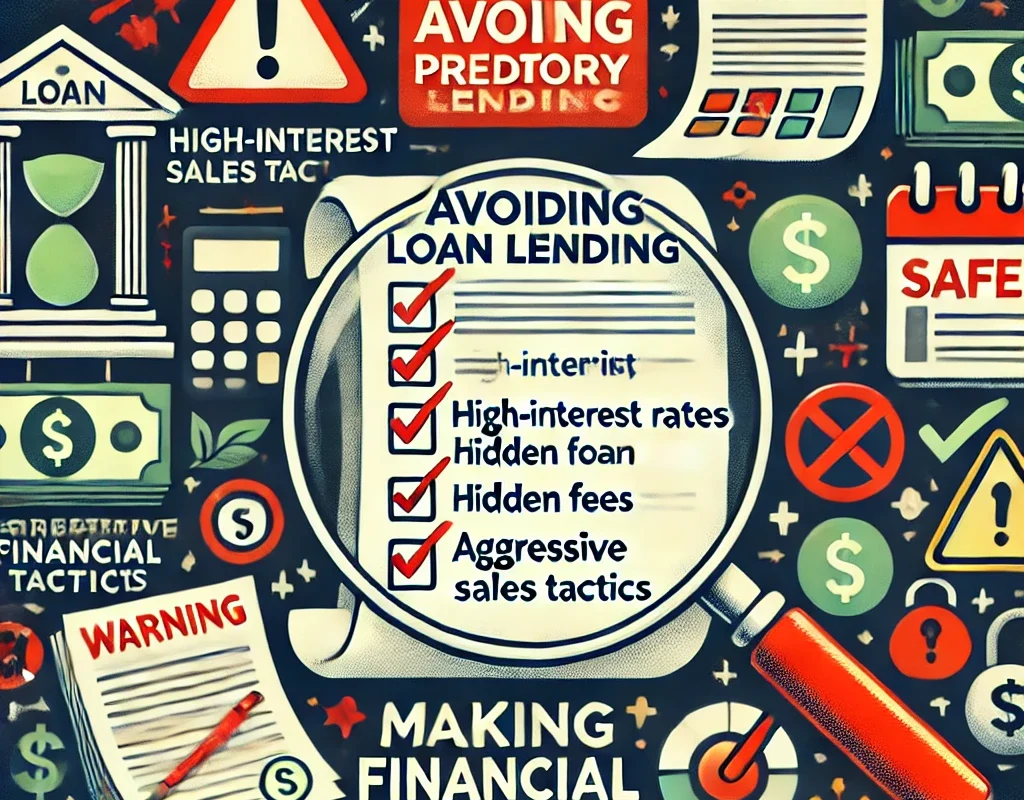Navigating the world of loans can be tricky. One wrong move, and you might find yourself caught in a web of predatory lending practices, where unscrupulous lenders trap borrowers in a cycle of debt. These loans often come with unfair terms, excessive fees, and high-interest rates that make repayment almost impossible. In this guide, we will uncover the tactics used by predatory lenders, offer practical advice to avoid these traps, and provide strategies for securing safer and more favorable loan terms.
Understanding Predatory Lending
Predatory lending refers to unethical practices by lenders that impose unfair or abusive loan terms on borrowers. These loans often target vulnerable populations, such as those with poor credit or low income, making it difficult for borrowers to escape the debt cycle. Predatory lenders rely on misleading advertising, hidden fees, and confusing jargon to trick people into accepting loans they can’t afford.
Predatory lending isn’t limited to payday loans or high-interest credit cards. It can appear in any type of lending, including mortgages, auto loans, and personal loans. Recognizing these tactics is the first step to avoiding financial pitfalls.
The Common Tactics of Predatory Lenders
Predatory lenders use several deceptive practices to take advantage of borrowers. Here are some of the most common tactics:
- Excessive Interest Rates: Predatory lenders often charge interest rates much higher than the market average, sometimes reaching rates as high as 400% in payday loans.
- Hidden Fees and Charges: Lenders may not fully disclose the fees associated with a loan upfront, leaving borrowers to discover these hidden costs only after the loan has been signed.
- Balloon Payments: Some predatory loans require small initial payments but include large, lump-sum payments at the end, catching borrowers by surprise.
- Pressure to Sign Quickly: Predatory lenders often push borrowers to sign loan agreements quickly, not allowing them time to fully understand the terms.
- Loan Flipping: This tactic involves encouraging borrowers to refinance their loans repeatedly, adding new fees and costs each time and trapping them in a cycle of debt.
Signs of Unfavorable Loan Terms
When considering a loan, it’s essential to look beyond the surface. Here are the red flags that signal unfavorable loan terms:
- High Annual Percentage Rate (APR): If the loan’s APR is significantly higher than what’s typical for your type of loan, this could indicate unfavorable terms. Compare rates from multiple lenders before committing.
- Lack of Transparency: If the lender is vague about fees, interest rates, or repayment terms, they may be trying to hide unfavorable terms.
- Prepayment Penalties: Some loans impose penalties if you try to pay off the loan early. This is a clear sign the lender is looking to trap you into paying more interest.
- Adjustable Interest Rates: Loans with variable interest rates might start low but can increase dramatically over time, making your payments unaffordable.
- Long-Term Contracts: Extending loan repayment periods may lower monthly payments but often results in paying significantly more in interest over the life of the loan.
Steps to Avoid Predatory Lending
Preventing predatory lending requires both awareness and preparation. Here are some key steps to protect yourself:
- Research Lenders Thoroughly: Always check the reputation of the lender. Look for online reviews, Better Business Bureau ratings, and any complaints filed with consumer protection agencies.
- Understand the Terms: Never sign a loan agreement without fully understanding the terms. If something is unclear, ask questions, and request clarification in writing.
- Compare Offers: Don’t settle for the first loan offer you receive. Shop around and compare interest rates, fees, and repayment terms from different lenders to find the most favorable terms.
- Check for Licensing: Make sure the lender is licensed to operate in your state. Unlicensed lenders may not follow state regulations designed to protect borrowers.
- Avoid Loans with High-Pressure Sales Tactics: If a lender is pushing you to sign quickly or making the offer seem too good to be true, walk away. Legitimate lenders will give you the time to review and consider the loan terms.
How to Negotiate Better Loan Terms
Securing favorable loan terms often comes down to negotiation. Here’s how you can approach the process:
- Improve Your Credit Score: Lenders offer better terms to borrowers with higher credit scores. Before applying for a loan, take steps to boost your credit score by paying down debt and making all payments on time.
- Ask About Interest Rate Discounts: Some lenders offer discounts for setting up automatic payments or having an existing relationship with the bank. Always ask if there are any rate reductions available.
- Negotiate Fees: Many loan fees, such as origination or processing fees, are negotiable. Don’t be afraid to ask for a waiver or reduction of these fees before agreeing to the loan.
- Shorten Loan Terms: While extending loan terms may lower your monthly payment, it also increases the amount of interest you pay over time. Opt for shorter loan terms when possible to save on interest.
The Importance of Loan Documentation and Transparency
One of the most effective ways to avoid predatory lending is to ensure you have all the necessary documentation and that the loan process is transparent. Always request a written copy of the loan agreement and review the terms carefully. Be wary of lenders who provide only verbal agreements or vague contracts.
Furthermore, ask for a breakdown of all costs associated with the loan, including fees, interest rates, and payment schedules. Transparency is key to avoiding any surprises down the line.
You can also read; How to Use a Personal Loan for Debt Consolidation Effectively
Protecting Yourself from Predatory Mortgage Lending
Mortgages are one of the most common areas where predatory lending occurs. Given the long-term nature of a mortgage, unfavorable terms can have devastating consequences. To protect yourself, consider the following tips:
- Get Pre-Approved by a Reputable Lender: Before shopping for a home, get pre-approved for a mortgage by a lender with a solid reputation. This gives you a clear understanding of how much you can borrow and prevents you from being lured by deceptive offers.
- Watch for High Loan-to-Value Ratios: Predatory mortgage lenders often offer loans with high loan-to-value (LTV) ratios, which means you’ll be borrowing a larger percentage of the home’s value. While this might seem beneficial, it often comes with higher interest rates and less favorable terms.
- Review the Good Faith Estimate (GFE): Before closing on a mortgage, you’ll receive a Good Faith Estimate that outlines the loan terms, fees, and closing costs. Review this document carefully to ensure the terms match what you were initially offered.
- Be Wary of Adjustable-Rate Mortgages (ARMs): While ARMs might offer low introductory rates, they can increase significantly over time, making your monthly payments unaffordable.




